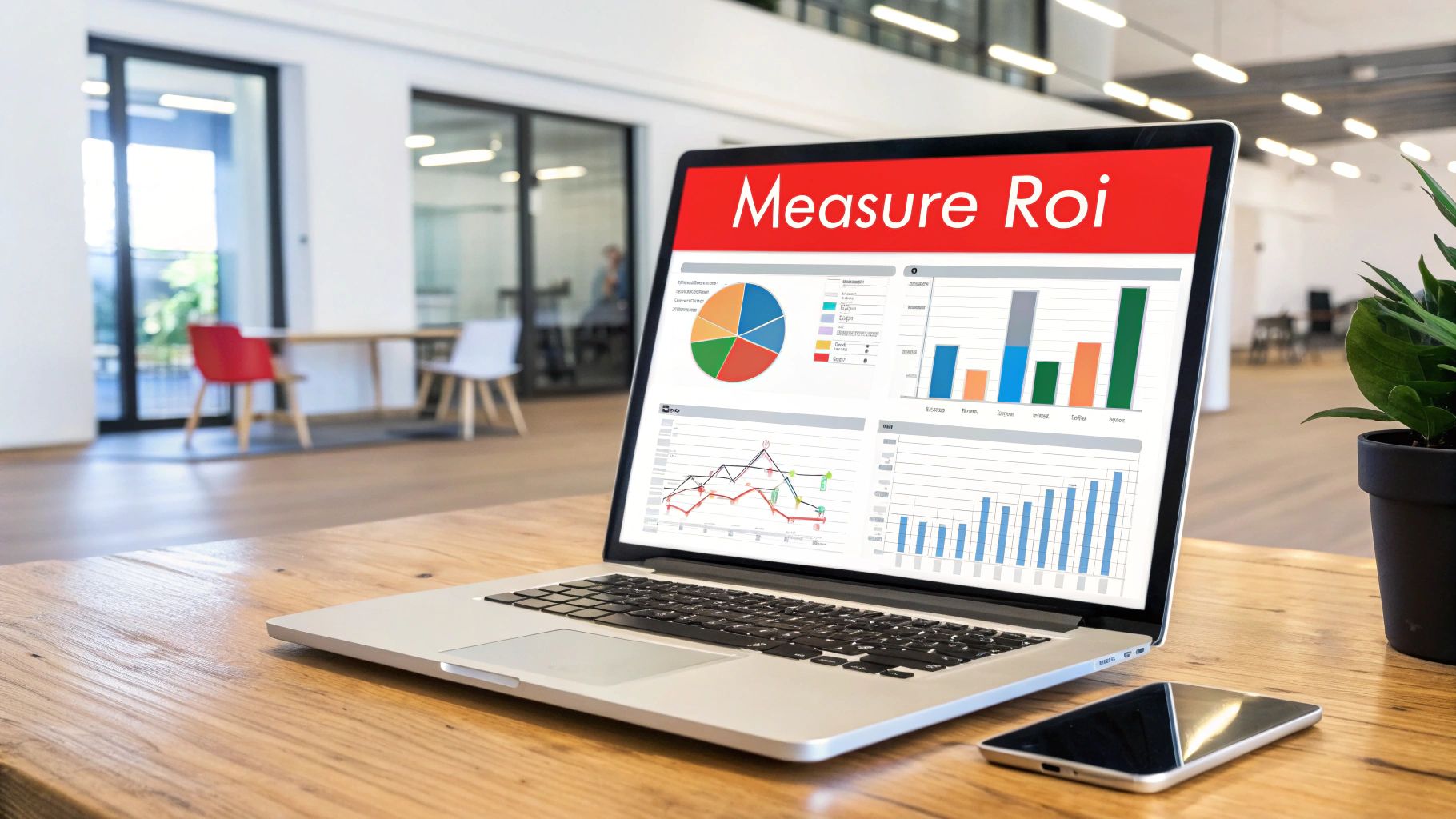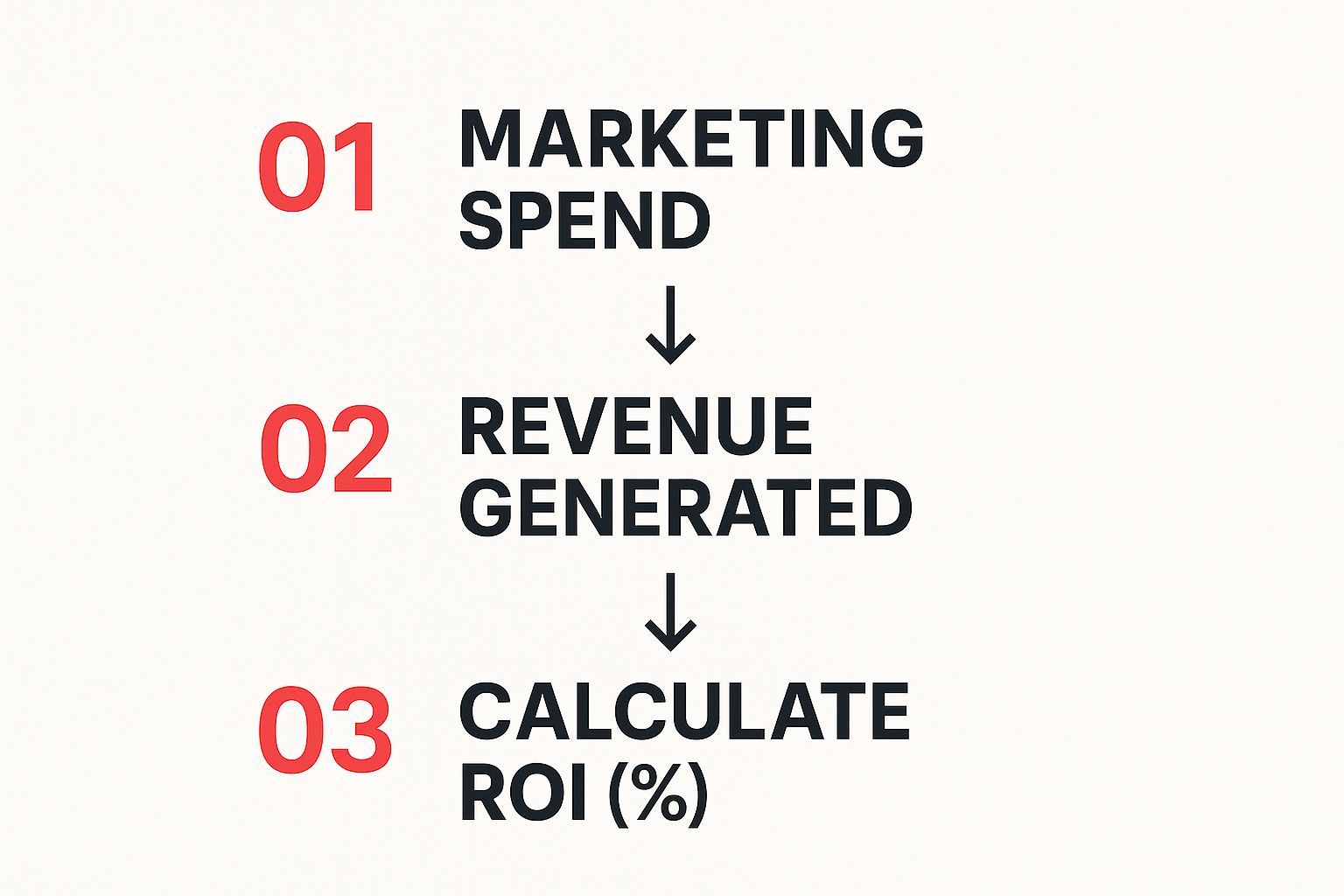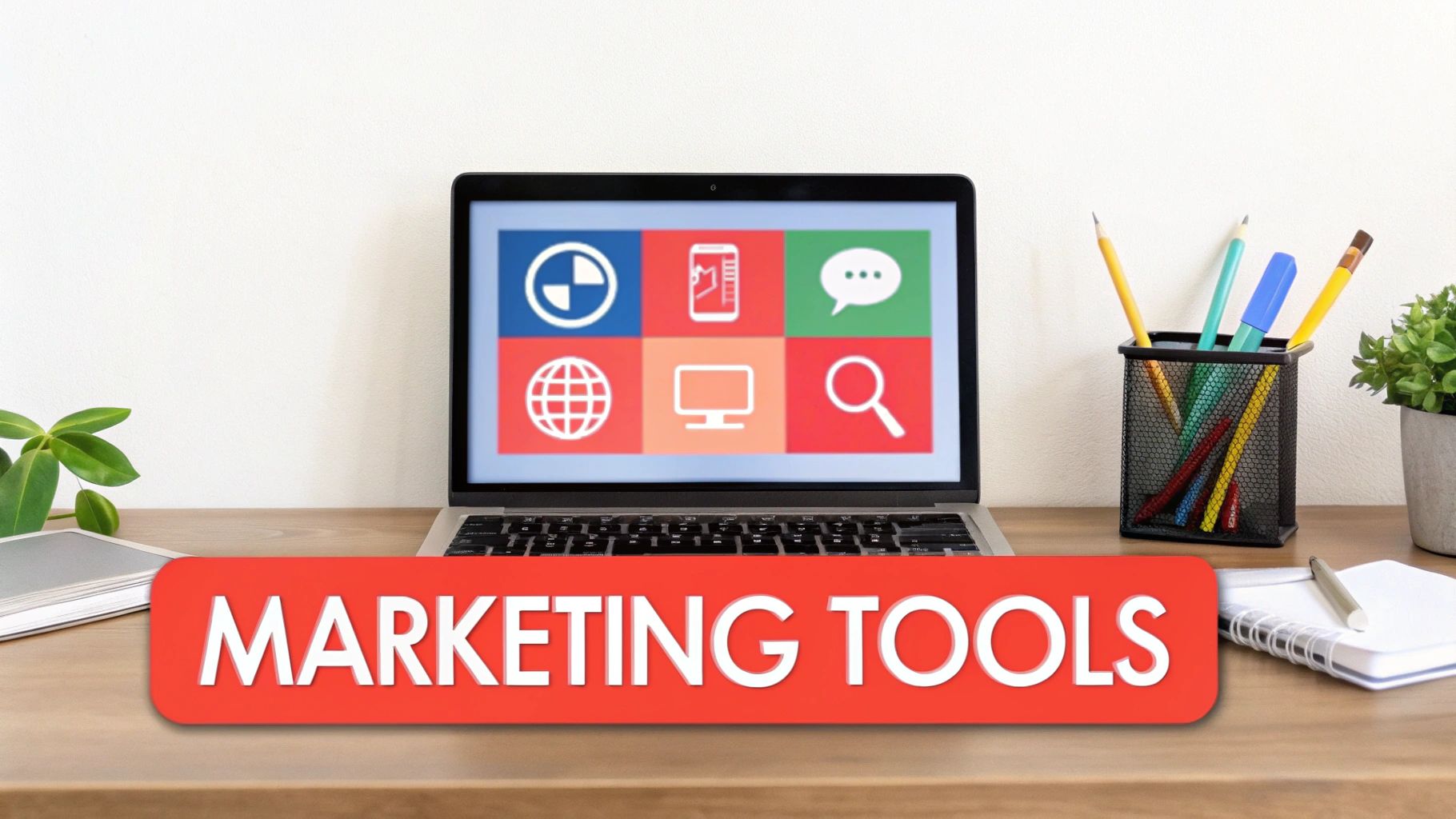Content marketing ROI is pretty simple at its core. It’s the money your business gets back from all your content efforts—your blogs, videos, social media posts—compared to what you spent to create and share them.
Basically, it answers the all-important question: “Is all this content actually making us any money?” Figuring this out is how you stop treating content as just another expense and start seeing it as a real, measurable engine for growth.
What Is Content Marketing ROI and Why It Matters

Think of your content strategy like planting a garden. You can’t just hope for a harvest; you have to invest upfront. Your investment is everything from the seeds (your ideas) and the soil (your writers and designers) to the water and fertilizer (your promotional budget and software tools). The return, or your ROI, is the value of that harvest—the actual revenue, the new leads, and the brand loyalty your garden produces.
If you don't measure your content marketing ROI, you're essentially gardening in the dark. You might be growing beautiful flowers that get a lot of attention (high traffic), but are they putting food on the table (generating sales)? Tracking ROI shines a light on what’s actually working, proving your team's value and making it much easier to ask for a bigger budget next quarter.
The Two Sides of the Content ROI Equation
To really get a handle on content marketing ROI, you need to be crystal clear about what counts as an investment and what counts as a return. It's not always as simple as money spent versus money earned. The equation is a bit more nuanced, and you have to account for all your resources and every kind of value your content creates.
Here’s a quick look at how to think about each side of the equation.
The Two Sides of the Content ROI Equation
| Component Type | Examples of What to Include | Primary Goal |
|---|---|---|
| Investment (The Costs) | - Freelancer fees or team salaries - Marketing software subscriptions - Ad spend for content promotion - Graphic design or video production costs |
To add up every resource you've dedicated to your content marketing. |
| Return (The Value) | - Direct revenue from sales - Value of new leads generated - Increased customer lifetime value - Savings from organic vs. paid traffic |
To put a dollar figure on the business results your content delivers. |
Getting these components right is the first real step toward building a clear financial picture of your content’s performance. For a much deeper dive into this process, check out our complete ROI of content marketing step-by-step success guide.
Why You Can't Afford to Ignore ROI
For any modern business, ignoring content ROI is a huge mistake. It’s the one metric that separates a successful, data-driven strategy from just throwing things at the wall and hoping something sticks. When you can walk into a meeting and prove a positive return, you change the entire conversation with leadership. It’s no longer, "How much does content cost us?" but "How much more should we invest?"
The financial impact here is no joke. For every $1 invested in quality content marketing, some businesses see an average return of around $42.
That number alone shows the incredible profit potential you could be tapping into. On top of that, consider that 73% of B2B marketers point to content marketing as their single most effective tactic for bringing in high-quality leads and closing sales.
When you track ROI, you gain the clarity you need to fine-tune your strategy, cut out wasteful spending, and put your resources behind what truly grows your business.
How to Calculate Your Content Marketing ROI
Putting a hard number on your content marketing ROI can feel a bit like trying to bottle lightning, but it's more straightforward than you think. The whole thing hinges on one simple formula.
(Return − Investment) ÷ Investment x 100 = Content Marketing ROI %
This little equation gives you a clear percentage. A positive number means you’re making money—hooray! A negative one means you’re in the red. The real trick isn't the math itself, but knowing exactly what to plug in for "Return" and "Investment."
This visual breaks down the process into three simple steps.

As you can see, it all starts with adding up your total spend. From there, you track the money that came back in, and finally, you use the formula to see how you did.
Tallying Up Your Total Investment
First things first, you need to know what you spent. This is where a lot of marketers get tripped up; they only count the most obvious costs. To get a true ROI, you have to account for every single dollar that went into creating and promoting your content.
Your total investment should include:
- Production Costs: This is what you paid your writers, designers, and video editors. If you have an in-house team, you’ll want to calculate a portion of their salaries.
- Software and Tools: Don't forget those monthly subscriptions! Think about your SEO tools, social media schedulers, or email marketing platforms. They all count.
- Promotional Spend: Did you run any paid ads on social media or search engines? That budget goes right here.
Small costs add up quickly. A portion of a project manager's time or the fee for stock photos can easily be overlooked. Aim to capture at least 90% of your costs for a reliable figure. For a deeper dive, it's always helpful to measure marketing success using a data-driven framework.
Assigning a Dollar Value to Your Return
Now for the "Return" side of the equation. This can feel a little more abstract because not every piece of content leads directly to a sale. Often, its main job is to bring in leads. The key is to figure out what a lead is actually worth in dollars and cents.
To do this, you’ll need to work backward from a sale with a little help from your sales team.
Example: Calculating the Value of One Lead
- Find Your Customer Lifetime Value (LTV): Let’s imagine your average customer is worth $2,000 over their entire relationship with your business.
- Get Your Lead-to-Customer Close Rate: Your sales team tells you they close 10% of the qualified leads marketing sends their way.
- Calculate Lead Value: Just multiply the LTV by your close rate. So, $2,000 x 0.10 = $200.
Just like that, you know every qualified lead your content generates is worth $200. If a blog post brings in 50 new leads, you can confidently say it generated $10,000 in value (50 x $200).
A Real-World Calculation Example
Let's pull this all together with a concrete example. Say you published a big, comprehensive guide on your blog.
-
Investment:
- Writer's Fee: $800
- Graphic Design: $200
- Promotional Ads: $500
- Total Investment = $1,500
-
Return:
- The guide brought in 20 qualified leads.
- Using our $200 lead value from the example above, the total return is 20 x $200 = $4,000.
Now, let's plug it all into our ROI formula:
($4,000 − $1,500) ÷ $1,500 x 100 = 167%
Boom. Your ROI for this one piece of content is 167%. This means for every dollar you put in, you got back $1.67 in profit. That’s a powerful number you can take to your boss to prove your content’s worth and make even smarter bets on your next campaign.
Tracking the Right Metrics for an Accurate ROI

Calculating your content marketing ROI is impossible without solid data. But drowning in numbers is just as useless as having none at all. To get a clear picture, you need to think like a pilot in a cockpit—focus on the handful of instruments that tell you where you are, how fast you're going, and whether you're actually on course to your destination.
Your content metrics fall into two main camps. The first group gives you immediate feedback on performance, while the second measures the ultimate impact on your business. You really need to understand both to get the full story of your ROI.
Leading Indicators: The Early Warnings
Think of leading indicators as the real-time gauges on that cockpit dashboard. They’re the early warning signs that tell you if your content strategy is on the right track or starting to veer off course. While they don't represent final dollar amounts, they are absolutely crucial for predicting future success.
These metrics show you that people are finding and interacting with your content. They are the essential first steps that have to happen before a sale can ever take place.
Key leading indicators to watch:
- Organic Traffic: How many people are finding your content through search engines? A steady climb here is a great sign your SEO work is paying off.
- Keyword Rankings: Are you moving up the search results for your most important terms? Higher rankings mean more visibility and, ultimately, more potential customers.
- Time on Page: When visitors land on your content, do they actually stick around to read it? Longer visit durations suggest your content is hitting the mark and providing real value.
- Social Shares and Backlinks: Are other people and websites sharing or linking to your content? This is a huge vote of confidence that builds your authority and drives referral traffic.
These metrics are your first signs of life. A blog post with a high time on page and growing organic traffic is a powerful asset, even before it generates a single lead.
Lagging Indicators: The Bottom Line
While leading indicators tell you how the journey is going, lagging indicators tell you if you've arrived at your destination: profit. These are the bottom-line metrics that directly measure business impact and are essential for your final content marketing ROI calculation.
They're called "lagging" for a reason—they often take time to show up. Someone might read three of your blog posts over several weeks before finally deciding to make a purchase. That sale is the lagging indicator of your content's earlier success.
Your most important lagging indicators are tied directly to revenue. These are the numbers that executives and stakeholders care about most because they measure the financial health and growth of the business.
Lagging indicators you absolutely must track:
- Leads Generated: How many potential customers did your content bring in? This could be demo requests, free trial sign-ups, or contact form submissions.
- Conversion Rate: What percentage of people who read your content end up taking the action you want them to? This shows just how persuasive your content really is.
- Sales Revenue: The big one. How much money did your content directly or indirectly help generate? This is the ultimate measure of your return.
- Customer Lifetime Value (CLV): Does your content help you keep customers who spend more with you over time?
To measure your returns accurately, it's vital to track the right key content performance metrics that connect directly to your business goals.
Connecting the Dots for a Full Picture
The real magic happens when you see the relationship between your leading and lagging indicators. The truth is, one directly influences the other. For example, improving your time on page (a leading metric) almost always leads to a higher conversion rate (a lagging metric), because readers who are genuinely engaged are far more likely to trust you and take the next step.
Focusing only on final sales is like trying to drive a car by only looking at the destination on a map, without ever checking your speed or your fuel gauge. Sure, you might get there eventually, but you'll have no idea how you did it or if you could have done it better.
Truly effective measurement requires a balanced view. By keeping an eye on your leading indicators, you can make smart, timely adjustments—like optimizing a low-performing article or doubling down on a high-traffic topic. If you're looking to scale your efforts, our guide on effective outsourcing content creation strategies can help. This proactive approach lets you improve your odds of hitting those all-important lagging indicators, turning your content into a predictable and powerful revenue driver.
Actionable Strategies to Boost Your Content ROI
https://www.youtube.com/embed/85IOxVKbKto
Knowing your content marketing ROI is a great starting point, but the real magic happens when you make that number grow. Improving your return isn't about churning out more content; it's about working smarter. It's about being intentional with every article, video, and social post you create so they don't just get views—they drive real business results.
This means you have to move past the "publish and pray" mindset. Instead, you need a solid game plan filled with proven tactics designed to squeeze the most value out of every dollar you spend. Think of these strategies as your blueprint for turning content from an expense into a reliable profit generator.
Master Search Intent to Attract Eager Buyers
First things first, you have to get inside your customer's head by mastering search intent. This is simply the "why" behind a Google search. What is someone really trying to do when they type a query into that search bar?
-
What it is: Search intent is the user's ultimate goal. Are they just looking for an answer (informational)? Trying to find a specific site (navigational)? Comparing options before they buy (commercial)? Or are they ready to pull out their credit card right now (transactional)?
-
Why it boosts ROI: When you create content that perfectly matches what the user wants, you attract people who are much further along in their buying journey. Instead of drawing in a crowd of casual browsers, you connect with an audience actively seeking the solutions you offer. This drastically increases your chances of making a sale.
For example, a blog post on "Best Running Shoes for Flat Feet" targets commercial intent, catching people who are literally in shopping mode. That will always deliver a better ROI than a generic post like "The History of Running Shoes."
Build Topic Clusters to Dominate Your Niche
Next up, build topic clusters. This is a powerful way to show both search engines and your audience that you're the go-to expert in your field.
A topic cluster is just a group of interlinked articles that all revolve around one core subject. You start with a big, comprehensive "pillar page" that covers the main topic from a high level. Then, you create several "cluster pages" that dive deep into specific subtopics, all linking back to the main pillar.
By organizing your content this way, you’re basically telling Google, "Hey, we know this subject inside and out." This helps you rank higher for a whole range of related keywords, which brings in more qualified organic traffic and boosts your content ROI over time.
A great example would be a pillar page on "Social Media Marketing" that links out to cluster content like "A Beginner's Guide to Instagram for Business," "How to Read Your TikTok Analytics," and "Pro Tips for Facebook Ad Strategies."
Design a Powerful Content Distribution Plan
Writing amazing content is only half the job. If you don't have a solid content distribution plan, even the most brilliant article will just sit there collecting digital dust, failing to deliver any return. You have to be proactive about getting your work in front of the right people.
Your distribution plan should hit multiple channels and be tailored to where your audience actually hangs out online. This should include:
- Email Marketing: Send your new content directly to your most loyal fans—your newsletter subscribers.
- Social Media Promotion: Share your content on all relevant platforms, and not just once. You can learn more about how to earn from social media in our detailed guide.
- Community Engagement: Post links and start conversations in relevant online communities like Reddit, Facebook Groups, or industry forums.
- Paid Amplification: Put some budget behind your best-performing content to push it to a wider, highly targeted audience.
The global content marketing industry is expected to grow to over $107.5 billion in 2025. With 46% of B2B marketers planning to spend more on content, a killer distribution plan is non-negotiable if you want to stand out and see a real return. You can check out more of these content marketing budget trends on AgencyHandy.com.
Repurpose Winning Content to Multiply Its Value
Don't let a great piece of content have a one-and-done lifespan. Repurposing content is all about taking something that performed well and transforming it into new formats to reach new audiences and keep it relevant for longer.
This strategy is incredibly efficient for boosting ROI because you're not starting from scratch. You already have proof that the topic is a winner; you’re just serving it up in a different way.
Smart Ways to Repurpose Content:
- Blog Post to Video: Turn that popular how-to guide into an easy-to-follow YouTube tutorial.
- Webinar to Blog Series: Slice up a one-hour webinar recording into several detailed blog posts.
- Data/Statistics to Infographic: Take the key numbers from a research report and create a visually appealing, shareable infographic.
Each new format gives you more bang for your buck, stretching your initial investment to maximize reach and engagement without doubling your workload.
Engineer Clear Conversion Paths
Finally, every single piece of content needs a job to do. You have to engineer clear conversion paths that smoothly guide a reader from simply consuming your content to taking an action that benefits your business.
This comes down to placing compelling calls-to-action (CTAs) that tell the reader exactly what to do next. Whether it's "Download the Ebook," "Start Your Free Trial," or "Book a Demo," the next step should be obvious and enticing. If you don't ask, you don't get. A missing CTA is like leaving money on the table.
Choosing the Right Content for Maximum Return

When it comes to your content, selectivity is everything. Think of your content budget like a personal investment portfolio. You wouldn't pour all your cash into a single, high-risk stock, right? You’d diversify. The same exact principle applies to content—different formats are designed for different jobs and deliver very different kinds of returns.
This isn't about creating content just to have something new on your site. It’s about being smart and investing your resources where they’ll actually make a difference to your bottom line. The goal is to find the right balance between big projects that build long-term authority and smaller pieces that drive immediate conversions.
High-Investment Assets vs. Consistent Performers
Some content pieces are the big hitters in your lineup. Think original research reports, comprehensive ebooks, or in-depth video courses. They demand a significant investment of time and money upfront, but their payoff can last for years. These assets establish you as a go-to expert, attract high-quality backlinks, and generate a steady stream of valuable leads long after you hit publish.
Then you have your consistent performers, like blog posts and articles. A single blog post probably won't change your business overnight, but their cumulative effect is undeniable. A steady stream of quality posts builds your SEO footprint, answers your customers' most pressing questions, and nurtures your audience over time. They are the backbone of a healthy content marketing ROI.
The Rise of High-Engagement Formats
Let's face it, today's audiences love quick, engaging content. Social media isn't just for socializing anymore; it's a massive sales channel, with social networks now accounting for a staggering 17.11% of all online sales worldwide. This shift has made formats like short-form video and user-generated content (UGC) incredibly valuable.
In fact, a whopping 71% of video marketers say short-form video delivers the best ROI of any format. And when you look at how people shop, 49% of consumers make purchases every month based on influencer recommendations. You can dig into more of these stats in the social media ROI findings on SproutSocial.com.
Authenticity is the real star here. User-generated content—where real customers share their experiences—builds trust in a way that polished corporate ads often can't. It turns your happy clients into your most powerful sales force.
Closing the Deal with Bottom-Funnel Content
While building awareness is crucial, the biggest ROI often comes from content that directly nudges someone toward a purchase. This is where bottom-of-the-funnel (BOFU) content really shines. These pieces are created for prospects who are right on the edge of making a decision.
- Case Studies: They show instead of just tell. By detailing how your product solved a real problem for a real customer, you provide the social proof many buyers need to finally commit.
- Comparison Pages: When someone is weighing your solution against a competitor's, a detailed and honest comparison page can be the very thing that keeps them on your site and seals the deal.
- Product Demo Videos: A clear walkthrough of your product in action clears up any lingering questions. It helps prospects visualize how it will work for them, directly pushing them toward a sale.
Finding the perfect mix of these content types is the secret to a great ROI. To help you visualize this, the table below maps out different content formats and their typical role in driving returns.
Mapping Content Formats to ROI Potential
| Content Type | Primary Goal | Typical Investment | Key ROI Metrics |
|---|---|---|---|
| Blog Posts | SEO, Brand Awareness, Nurturing | Low to Medium | Organic Traffic, Keyword Rankings, Time on Page |
| Short-Form Video (Reels) | Engagement, Brand Reach | Low | Views, Shares, Follower Growth, Website Clicks |
| Original Research Report | Authority, Lead Gen, Backlinks | High | Report Downloads, Media Mentions, Lead Quality |
| Case Studies | Conversion, Sales Enablement | Medium | Conversion Rate, Influenced Revenue, Sales Cycle Length |
| Comparison Pages | Decision-Stage Conversion | Medium | Demo Requests, Trial Sign-ups, Direct Sales |
As you can see, there's no single "best" type of content. A strong strategy uses a blend of these formats—from low-effort, high-engagement videos to high-investment, authority-building reports—to meet customers at every stage of their journey.
Common Questions About Content Marketing ROI
Even with a clear formula in hand, trying to calculate your content marketing ROI can feel a bit like navigating a maze. It’s normal to hit a few tricky spots. Let's walk through some of the most common questions and sticking points that come up, so you can measure your efforts with real confidence.
How Long Until I See Content Marketing ROI?
If there's one golden rule in content marketing, it's patience. Think of it like planting a garden, not flipping a light switch. You're nurturing something that will grow over time. It's rare to see a significant financial return in the first 3-6 months. Your content needs time to get discovered by search engines, build links, and start drawing in an audience.
You'll likely see early signs of life, like a slow climb in organic traffic or better keyword rankings. But the real payoff—a reliable stream of quality leads and sales—often takes 6 to 12 months to really kick in. That's when your content starts building true authority.
Don't sweat it if your new blog isn't ringing the cash register in the first quarter. Keep an eye on those early metrics like traffic and engagement. They’re your sign that you're on the right track for long-term success.
What If My Content Doesn't Directly Cause a Sale?
This happens all the time, and it's completely normal. Most of your content, especially things like educational blog posts or fun social media videos, isn't meant to close a deal on the spot. Its job is to make people aware of your brand, earn their trust, and get your foot in the door with new audiences.
So, how do you measure the value of this "assisting" content? You have to look beyond the very last click a customer made.
- Look for Assisted Conversions: Tools like Google Analytics can show you all the touchpoints in a customer's journey. You'll see which articles or videos they viewed along the way, even if another channel got the final credit.
- Value Your Lead Magnets: Did a blog post convince someone to download your free ebook? Great. You can calculate its return based on how many leads it generated and what a lead is typically worth to your business.
- Check for Brand Lift: Is your brand search volume going up? When more people start searching for your company name directly, it's a strong signal that your awareness efforts are working.
What Are the Biggest Mistakes to Avoid?
When you sit down to run the numbers, a few common slip-ups can throw off your entire calculation and lead you to make the wrong decisions. Knowing what they are is half the battle.
Here are the two biggest mistakes to watch out for:
- Forgetting Hidden Costs: It's easy to remember the freelance writer's invoice but forget everything else. If you don't account for software subscriptions, a percentage of your team's salaries, or the money spent on social media ads to promote the content, your ROI will look much better than it actually is.
- Ignoring the Full Customer Journey: This is a classic. Relying solely on "last-click" attribution gives 100% of the credit to the final piece of content a person saw before buying. It completely ignores the blog post that first introduced them to your brand or the social media update that kept them engaged.
Ready to skip the slow organic growth and start earning from your content immediately? MonetizedProfiles offers fully approved TikTok and YouTube accounts, so you can bypass the grind and begin generating ad revenue from day one. Get your monetized account and jumpstart your creator career.






